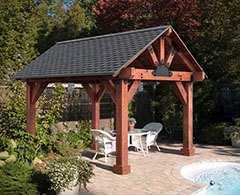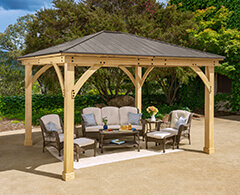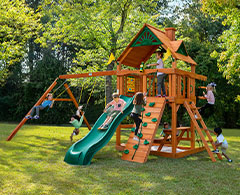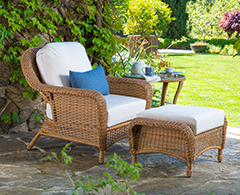During the winter months, your shed likely lays dormant; great for storage, but not much else. Now that spring is coming, it’s time to make sure your shed is in good shape for the coming year and capitalize on that spring cleaning energy! Whether you’re cleaning out your garden shed to get ready for planting season, or you want to reorganize the items you have in storage, we’ve got you covered with tips and tricks for how to clean your shed, inside and out.
Cleaning the Inside of Your Shed
The prospect of cleaning your whole shed may be overwhelming. It’s always easier to break down a large task like this into smaller chunks. Let’s start with the inside of your shed, since you’ll likely want to clear out your belongings before cleaning the outside. Make sure you have any tools or cleaning supplies you may need from the get-go: dust cloths, a broom, a mop, etc.
Clear Out Your Belongings
If you really want to clean your shed, you’ll need to remove everything from it. Even if it’s on a shelf or hanging on a wall. If you don’t take everything out of the shed, you won’t be able to properly clean and maintain every nook and cranny. Choose a day when the weather will be nice, or store the items from your shed in your house or garage. This way, your belongings won’t get damaged by the wet or cold.
Keep, Throw Away, or Donate Items
As you remove all of your belongings from your shed, you can start organizing them right away. Consider putting everything into three piles or categories: things you plan to keep, things you want to donate or sell, and finally, everything that needs to be thrown away. Create a plan for donating or selling old clothes, furniture, etc. as soon as possible so that you can be sure that your items marked for donation don’t end up back in your shed or garage. Doing this step now will help you figure out how you want to organize your shed when you put everything back. Perhaps you decide you want to make a few improvements to your shed or change the way you use it!
Check for Pests, Mildew, and Holes
This is one of the most important steps in the shed cleaning process, so don’t skip it! Check every corner of your shed for any possible pests: bugs, mice, etc. If you believe you have a pest problem, set traps right away or call an exterminator. Also, check for mold and mildew – less common in a waterproof shed, but still possible over time – which you can remove with a bleach solution or a mold remover from a hardware store.
Finally, check for any holes or cracks that may have appeared during the winter months. You should check both from the inside and the outside of your shed to make sure you don’t miss anything. Inspect carefully around the windows, and patch up any cracks or holes you find.
Dust, Sweep, and Mop
Now that you’ve done some basic maintenance, it’s time to clean. Sweep away the dirt, dust shelves, clear cobwebs out of corners, clean the windows, and mop the floor. Clean up any spills, especially oil spills if you keep vehicles in your shed. If your shed has carpet, you may want to use a steam cleaner on it (or hire a professional carpet cleaner), since this may be the only time of year you fully clean out your shed.
You will not be able to do most of these things when your shed is filled with your belongings, so this is your opportunity to clean the stains and accumulating dirt that has been bothering you. And clearing away any dirt or grime will help keep pests away for another year. Think about how good it will feel to walk into your shiny, clean storage shed once you finish this big cleaning project.
CLEANING THE OUTSIDE OF YOUR SHED
Before you put everything back inside, you’ll want to make sure the outside of your shed is in tip-top condition too. Grab your garden hose, a trusty cleaning solution or soap, and get started.
Wash the Outside
You may want to jump straight to a power washer if your shed’s exterior is very dirty, but be aware that pressure washing may erode the wood over time. If you do decide to use a power washer, avoid the windows and clean them separately.
Alternatively, you can use a gentler setting on your hose and still clean your shed thoroughly without the risk of harming the wood or chipping off paint. Use a spray setting that will allow you to clean your shed quickly and effectively. You can make this easier on yourself by washing your shed as it gets dirty throughout the year, rather than just doing one big clean. Here are more tips for shed maintenance, cleaning, and upkeep.
Check the Roof
You should check the roof throughout the year and clear off any debris that accumulates, but this is a great time to look for problems that have cropped up over the winter. Sometimes moss can grow on the roof of your shed, which can lead to moisture and water leaking in and can weaken the roof’s structure.
There may also be holes or cracks in the roof, which will need to be patched up. Just like the walls, any breach in the roof’s structure can lead to long-term damage to your shed and your belongings, as holes and cracks allow water to get inside.
Add a Coat of Paint
This is not going to be necessary every year, especially if you initially paint your shed with high-quality weatherproof paints or stains. But every few years, you’ll want to take on the task of re-painting your shed. Consider whether you want to try out a new color to freshen things up; this is the time to reimagine your shed and make it exactly what you want it to be.
Putting Your Shed Back Together
Now that you’ve cleaned your shed inside and out, let’s put it back in order. Or, you might find an entirely new way to use your storage space and renovate parts of your shed.
Re-Evaluate Your Space
Is your shed doing what you need it to do? Maybe you’re using it for storage space, but you want to convert it into an office. Or maybe you still want to use it for storage space, but you have a new hobby, which means you have to organize things in a different way. Before you move everything back (or move new items into your shed), make a plan for where everything will go so you’re not stuck rummaging around in boxes for your winter clothes in six months. Label boxes and containers that will be closed for a long time so you don't forget what's inside.
Make Improvements
This is the perfect opportunity to add all of the improvements you’ve been dreaming of. These can be large-scale things (if you're completely changing what you'll use your shed for), but they don’t have to be. Simply hanging new hooks or shelves can make a huge difference in how you organize your shed. If you’re not using much of your shed’s vertical space, hooks and shelves will be a game-changer. Your belongings will no longer end up strewn across the floor, or hidden and inaccessible in back corners. Even buying new containers, bins, and baskets for organization can drastically change how tidy your shed looks.
Put Items Back Your Way
The organizational system that works for you will be the one that you can remember easily. If that means putting everything back in the same place it was before, do it! If that means putting everything in clear containers or labeled boxes so you know where everything is at a glance, do that. We can make suggestions, but the best way to use your shed is up to you.
Heartland Sheds: Sheds Built to Last the Seasons
If you’re in the market for a new shed, consider how it will stand up to common issues like mold, pests, and regular wear and tear from weather. A good-quality, weatherproof shed will drastically reduce the amount of upkeep you’ll need to do, especially in the first few years of ownership. Check to see if the shed comes with treated siding, what kind of framing or materials the shed is made of, etc. Heartland Sheds provides a wide variety of shed designs, all with the same reliable protection from the common pesky problems that might crop up when your shed is buried under snow during the winter.







